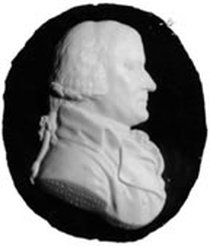John Millar (1735-1801)

John Millar was born in Lanarkshire on 22 June, 1735, the son of a minister of the Church of Scotland. When his father was transferred to a church in Hamilton in 1737, the young Millar went to live with his father’s brother, John, with whom he would reside for the next five years. He attended grammar school in Hamilton beginning in 1742, and entered the University of Glasgow in 1746, at the age of eleven. While there, he attended the lectures of Adam Smith, who arrived at the university in 1751.
In 1759 Millar married Margaret Craig; they would have thirteen children, eleven of which (four boys, seven girls) survived infancy. After being admitted to the bar in 1760, Millar accepted an offer to reside in the home of Lord Kames, in order to supervise the education of Kames’ son. During this time he also made the acquaintance of David Hume, whose metaphysics he would later defend against the criticisms of Thomas Reid and whose nephew — a future professor of law himself — he taught.
In 1761, with the support of Adam Smith and Lord Kames, Millar was elected to the Chair of Civil Law at Glasgow. His regular teaching duties included a course on Civil (Roman) Law and another on Public Law, or the Principles of Government. Millar was very popular in the classroom on account of the manner of his teaching, as well as for his enthusiasm for his subject and his personal support for his students. He was also extremely active in faculty matters during his forty years at the university.
Millar’s activities in Glasgow extended beyond the university campus. In addition to teaching law, he practiced it, trying cases personally, as well as serving as both Counsel and arbitrator. He was a member of the Literary Society, a club founded by Smith in 1752 that included among its members the philosopher Thomas Reid, the inventor James Watt, and the chemist William Cullen. Millar, always a defender of personal liberty, was also active in the anti-slavery movement of his day.
Millar’s most well-known work is The Origin of the Distinction of Ranks (1771). It went through four editions, the final of which appeared in 1801 and contained an ‘Account of the Life and Writings of John Millar’ written by Millar’s nephew John Craig. The book adopts a stadial model of human social history to examine a series of authority relations. The most well-known of these analyses is the first chapter, which looks at the ways in which women’s social status increases or decreases as the dominant mode of production in a society changes.
Other works include a constitutional history of Britain entitled An Historical View of the English Government (1787) and a collection of political papers critical of the British government’s decision to go to war with France published as Letters of Crito (1796).
John Millar died on 30 May, 1801.
Fred Ablondi, Hendrix College
Enlightenment Philosophers
- Alexander Gerard ((1728-1795)
- Gershom Carmichael (1672-1729)
- Archibald Campbell (1691-1756)
- Francis Hutcheson (1694-1746)
- Henry Home, Lord Kames (1696-1782)
- Robert Wallace (1697-1771)
- George Turnbull (1698-1748)
- Thomas Reid (1710-1796)
- David Fordyce (1711-1751)
- David Hume (1711-1776)
- James Burnett, Lord Monboddo (1714-1796)
- Hugh Blair (1718-1800)
- George Campbell (1719-1796)
- William Robertson (1721-1793)
- Adam Smith (1723-1790)
- Adam Ferguson (1723-1816)
- John Millar (1735-1801)
- James Beattie (1735-1803)
- Dugald Stewart (1753-1828)
- Archibald Alison (1757-1839)